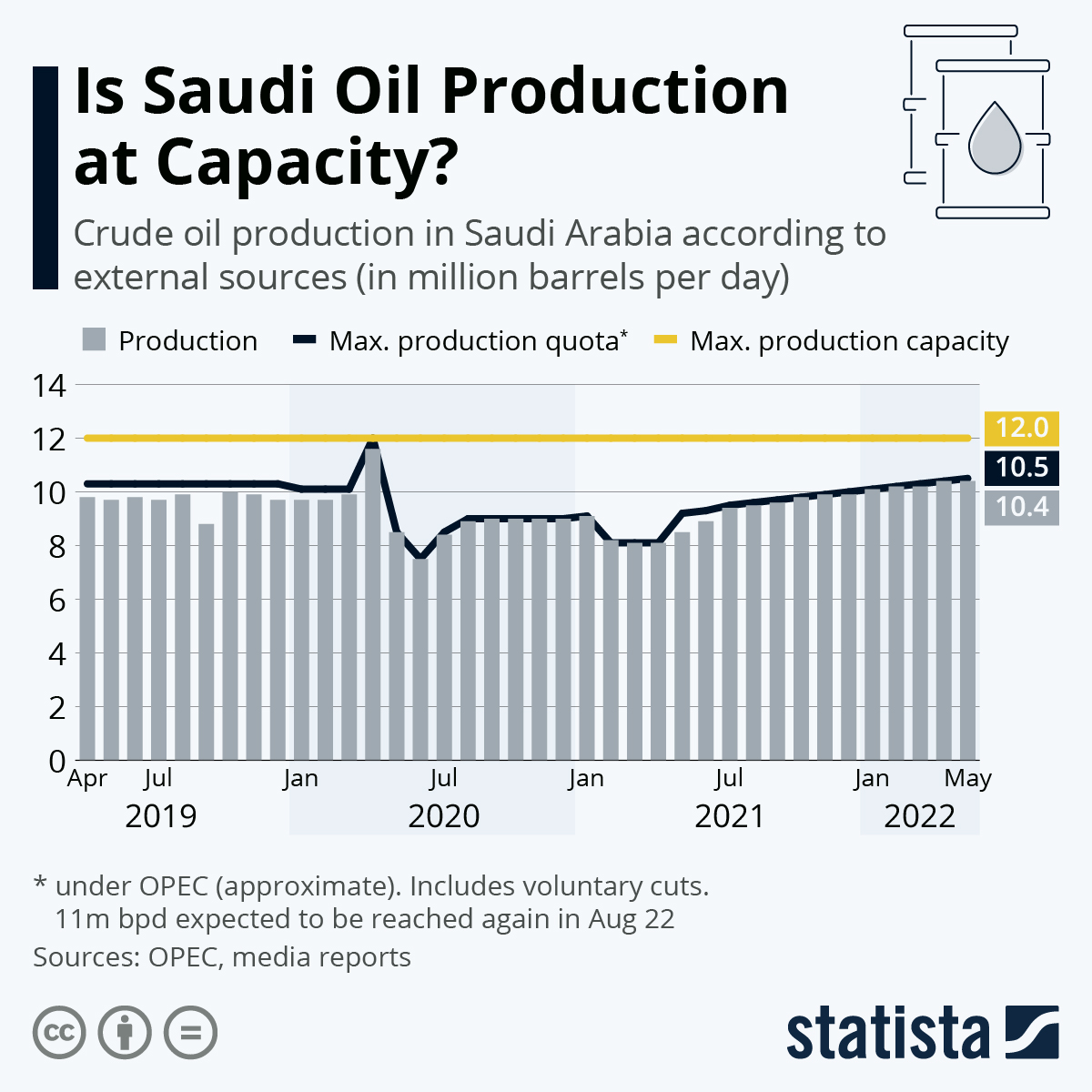
Use it or lose it – this principle might apply to Saudi Arabia’s oil production capacity that is now eyed by the Western world to fill the Russia-sized gap in supply left behind by embargoes.
However, as Statista's Katharina Buchholz details below, Saudi Arabia in the past three years only approached its declared maximum production capacity of 12 million barrels per day in one month, casting doubts on the kingdom’s ability to quickly up its production to stabilize world markets. According to Bloomberg, such predictions have come from UAE leadership, who together with the Saudis are the only OPEC members who have spare production capacity – at least on paper.
You will find more infographics at Statista
Joe Biden is traveling to Saudi Arabia this week and the increase of the global oil supply will be on the top of the agenda for the U.S. president. Up until now, the Gulf kingdom and its OPEC allies have been reluctant to make major changes as a result of the Russian invasion of Ukraine. OPEC stuck to its slow production increases that were scheduled to reverse Covid-era cuts between March and June, and only recently agreed to up production quotas faster in the coming months in the light of the dramatic world market developments. Saudi Arabia’s OPEC production quota for August 2022 stands at 11 million barrels a day – more than it has been in a long time and still a whole million barrels a day below the country’s elusive maximum quota.
As seen in data by the organization, Saudi Arabia has remained below its production quota prior to the Covid-19 epidemic and only once approached its declared maximum production capacity in April 2020 amidst a row with Russia that saw production quotas go out the window. The following months, the kingdom stood down, accepting lower production quotas than its rival on a voluntary basis.
If the Saudis can in fact produce more, they might also not want to.
Driving oil production to the edge of what is possible globally holds an inherent risk should another disruption, like it happened recently in Libya due to political unrest, should occur. Since that disruption can then not be compensated at all, it could cause an even more drastic jump in oil prices.
Use it or lose it – this principle might apply to Saudi Arabia’s oil production capacity that is now eyed by the Western world to fill the Russia-sized gap in supply left behind by embargoes.
However, as Statista’s Katharina Buchholz details below, Saudi Arabia in the past three years only approached its declared maximum production capacity of 12 million barrels per day in one month, casting doubts on the kingdom’s ability to quickly up its production to stabilize world markets. According to Bloomberg, such predictions have come from UAE leadership, who together with the Saudis are the only OPEC members who have spare production capacity – at least on paper.
You will find more infographics at Statista
Joe Biden is traveling to Saudi Arabia this week and the increase of the global oil supply will be on the top of the agenda for the U.S. president. Up until now, the Gulf kingdom and its OPEC allies have been reluctant to make major changes as a result of the Russian invasion of Ukraine. OPEC stuck to its slow production increases that were scheduled to reverse Covid-era cuts between March and June, and only recently agreed to up production quotas faster in the coming months in the light of the dramatic world market developments. Saudi Arabia’s OPEC production quota for August 2022 stands at 11 million barrels a day – more than it has been in a long time and still a whole million barrels a day below the country’s elusive maximum quota.
As seen in data by the organization, Saudi Arabia has remained below its production quota prior to the Covid-19 epidemic and only once approached its declared maximum production capacity in April 2020 amidst a row with Russia that saw production quotas go out the window. The following months, the kingdom stood down, accepting lower production quotas than its rival on a voluntary basis.
If the Saudis can in fact produce more, they might also not want to.
Driving oil production to the edge of what is possible globally holds an inherent risk should another disruption, like it happened recently in Libya due to political unrest, should occur. Since that disruption can then not be compensated at all, it could cause an even more drastic jump in oil prices.





